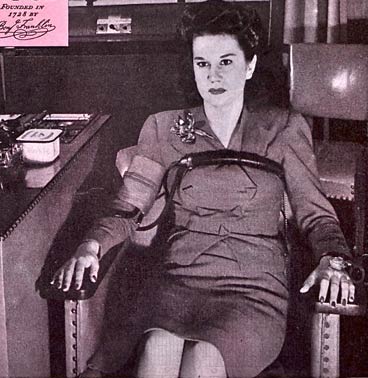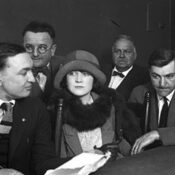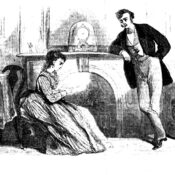First of all, it’s not a “lie detector.” The proper name is “polygraph”—Greek for “many pictures.” Its inventors never claimed it could detect lies, just gives multiple pictures of emotional reactions, particularly the rise in pulse, blood pressure, perspiration, and breathing that accompanies lying.
In 1948, when it was still a new concept, Alva Johnston wrote a three-part series on the polygraph and Leonarde Keeler, one of its chief developers. He noted that Keeler and other scientists
don’t like the name “lie detector.” The detection of lies is incidental; primarily, the machine measures emotion. The emotion which it usually registers is fear—fear of exposure and punishment. But the term “lie detector” is here to stay.
And to confirm that last statement, Johnston titled his series, “The Magic of the Lie Detector.” Keeler would have been disappointed by that choice of words. (He must have winced at “magic.”) He knew the limits of his device. But he also knew the polygraph could help in criminal investigations because of the popular misconception that the polygraph could, indeed, recognize any lie.
The most striking thing about the detector is the way that it induces confessions. The majority of suspects and of lying witnesses seem to think that the only logical thing to do is to confess when the detector trips them up. According to the figures of the Chicago Police Detection Laboratory, 75 per cent of those registering deception on the machine confess later.
The polygraph is far from accurate. Personal reactions between suspects vary widely. Any conclusion by an examiner involves subjective interpretation. But even with its limited reliability, the polygraph gave researchers enough information to indicate Americans were less honest than generally assumed. As early as 1931, Keeler was shocked to see how widespread theft and deception was among bank employees. He had been asked to administer polygraph tests to 54 staff members at a bank where $1600 had gone missing.
To his astonishment, twelve of them gave guilty reactions. Nine of them confessed. Horrified, the bank president fire all twelve.
He then sent all candidates for the vacancies to be tested on the lie detector. At this point Keeler got a second and worse shock. Sixty-two per cent of the applicants were found to have stolen from previous employers.
Thousands of employees and applicants have been examined on the lie detector since that time. The average of 62 per cent of dishonesty remains fairly constant for groups in a position to take small sums without great immediate danger of being caught. The percentage is higher in chain stores, where small items can be pilfered without much risk. General lie-detector experiences indicate that a considerable majority of the population will commit petty thefts when the opportunities are frequent and tempting.
That discouraging 62% was probably accurate, and has stayed fairly constant. In 2010, the National Retail Foundation reported that store and small businesses annually lose $33 billion in theft —60% committed by employees. The U.S. Chamber of Commerce claims 75% of employees steal from work, most of them repeatedly.
Back in the 1930s and ’40s, before hidden cameras and electronic inventory control, businesses had only a few defenses against employee crime. They repeatedly hired Keeler to tell them how honest their employees were. Again and again, Keeler found petty pilfering, cheating, and deception. But when he tested employees at a summer resort in Northern Michigan, he was startled to find complete honesty among one profession.
It wasn’t the bartenders.
The machine indicated that eleven of the twelve bartenders were guilty of irregularities. They confessed. They had pocketed money that should have gone into the cash register, had short-changed customers and had smuggled out occasional flasks for their own use.
It wasn’t the waiters or cleaning crew.
other employees confessed [to having] stolen from bedrooms, cheated guests, tapped tills and raided hotel supplies.
The island of honesty was found among the gamblers who ran the card and dice tables in the hotel’s casino.
All the gamblers ran 100-per-cent records of honesty. The boss gambler explained the matter to Keeler. Honesty was a part of the technical equipment… The professional staff had to put on their consciences every night, as actors put on their make-up. This particular joint did not cater to the sucker trade. Its customers were sophisticated, big-money players. If there was any cheating going on, they were sure to discover it. The staff couldn’t afford to be anything but scrupulously upright, since a single piece of crookedness might ruin the establishment. They couldn’t get along without honesty, no matter how much they hated it.
The number of cheats may be disheartening—at least for the 40% of American employees who never lie or steal. But there is one last discovery that Keeler made in his examinations that offer a slim piece of encouragement.
The lie detector acts as a mechanical conscience. A man who has been tripped up by it knows that he can be tripped up again if he makes another false move.
Getting caught on the lie detector is a sort of moral vaccination, a shot of integrity in the arm. Sir William Osler said that nothing promoted, longevity so much as the early discovery of a trace of organic disease. In the same way, nothing seems to promote honesty so much as the early discovery of a trace of larceny.
In one large retail chain which lost $1,400,000 a year through employee thefts Keeler discovered that 76 per cent of the personnel had been taking property of the company. On re-examination a year later, only 3 per cent of the thieves were found to have repeated. This did not mean, according to Keeler, that the other 97 per cent had got religion or been morally revolutionized, but that they could not bear the humiliation of being detected.
So maybe, with enough detection, there’s still hope for dishonest workers.
Post script: I found this detail from Johnston’s article interesting, if true:
Women usually put up a much better fight against the lie detector than men. They lie more skillfully and stick to a lie with greater resolution. As Keeler analyzes his experiences, it is not that a woman is naturally more dishonest than a man, but that, as a rule, she is a more determined character.
Become a Saturday Evening Post member and enjoy unlimited access. Subscribe now




Comments
Insiders call a defective lie detector a “Washington”–because, of course, it cannot tell a lie.
I operate a polygraph,
A lie detector called a lot.
I detect cash on my behalf.
The gizmo’s been my own jackpot.
I say to the examinee
If he/she wants to pass the test,
There will be a passing test fee.
At first most think I speak in jest.
But some who have turned down my deal
Have gotten fired or gone to jail.
I tell of this in my appeal.
Most give in and I’ve made my sale.
Polygraph – my money machine.
I’m not lying – know what I mean?